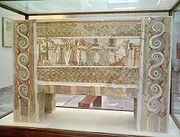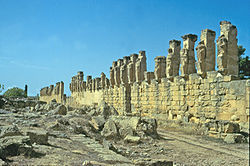
Luigi Pernier
Encyclopedia

Career


Rodolfo Lanciani
Rodolfo Amedeo Lanciani was an Italian archaeologist, a pioneering student of ancient Roman topography, and among his many excavations was that of the House of the Vestals in the Roman Forum....
as his supervisor. He specialised at the Scuola di Archeologia di Roma, gaining a diploma in 1901, after spending periods studying in Crete
Crete
Crete is the largest and most populous of the Greek islands, the fifth largest island in the Mediterranean Sea, and one of the thirteen administrative regions of Greece. It forms a significant part of the economy and cultural heritage of Greece while retaining its own local cultural traits...
at the Missione Archeologica Italiana under Federico Halbherr
Federico Halbherr
Federico Halbherr was an Italian archaeologist and epigrapher, known for his excavations of Crete.-Life:...
.
From 1902 to 1916 he was inspector of 'Museums, Galleries and Excavations of Antiquities' in Florence
Florence
Florence is the capital city of the Italian region of Tuscany and of the province of Florence. It is the most populous city in Tuscany, with approximately 370,000 inhabitants, expanding to over 1.5 million in the metropolitan area....
and carried out research at several central Italian sites; at the same time he joined the Italian Mission to Crete
Crete
Crete is the largest and most populous of the Greek islands, the fifth largest island in the Mediterranean Sea, and one of the thirteen administrative regions of Greece. It forms a significant part of the economy and cultural heritage of Greece while retaining its own local cultural traits...
, directing its operations from 1906 to 1909 in place of Halbherr while the latter was detained in Italy. It was at this time that Pernier was involved in the discovery of the Phaistos Disc
Phaistos Disc
The Phaistos Disc is a disk of fired clay from the Minoan palace of Phaistos on the Greek island of Crete, possibly dating to the middle or late Minoan Bronze Age . It is about 15 cm in diameter and covered on both sides with a spiral of stamped symbols...
. In 1904 he married Tonina Falchi, daughter of Isidoro Falchi
Isidoro Falchi
Isidoro Falchi was an Italian doctor and self-taught archaeologist. He is notable for his discovery of the Etruscan remains at Vetulonia and the necropolises at Populonia....
, who had discovered the site of Vetulonia
Vetulonia
Vetulonia, formerly called Vetulonium , was an ancient town of Etruria, Italy, the site of which is probably occupied by the modern village of Vetulonia, which up to 1887 bore the name of Colonnata and Colonna di Buriano: the site is currently a frazione of the comune of Castiglione della Pescaia,...
. From 1909 he was the first director of the newly-established Italian Archaeological School of Athens.
In 1914 he was made director of the Archaeological Museum of Florence, giving up his directorship of the Athens school. In 1916 he was appointed superintendent of excavations and archaeological musueums of Etruria, a position he held until 1922, when he became professor of archaeology and ancient art history at the University of Florence
University of Florence
The University of Florence is a higher study institute in Florence, central Italy. One of the largest and oldest universities in the country, it consists of 12 faculties...
. Pernier spent long periods abroad during this time, especially in the summer, on Crete or in Cyrene
Cyrene, Libya
Cyrene was an ancient Greek colony and then a Roman city in present-day Shahhat, Libya, the oldest and most important of the five Greek cities in the region. It gave eastern Libya the classical name Cyrenaica that it has retained to modern times.Cyrene lies in a lush valley in the Jebel Akhdar...
. On Crete, from 1928 to 1929, he completed the excavations on the palace at Phaistos
Phaistos
Phaistos , also transliterated as Phaestos, Festos and Phaestus is an ancient city on the island of Crete. Phaistos was located in the south-central portion of the island, about 5.6 kilometres from the Mediterranean Sea. It was inhabited from about 4000 BC. A palace, dating from the Middle Bronze...
before becoming director of the Italian Archaeological Mission on Halbherr's death in 1930.
At Cyrene, from 1925 to 1936, Pernier carried out ten excavation campaigns as part of the Italian Archaeological Mission and (with Carlo Anti
Carlo Anti
Carlo Anti was an Italian archaeologist and academic. He also served as an army official from the First World War until 1922. From 1925 to 1936 he assisted Luigi Pernier in excavations on the Sanctuary of Apollo at Cyrene. In the inter-war years he also became a professor at the university of...
) led the excavations on the Sanctuary of Apollo
Apollo
Apollo is one of the most important and complex of the Olympian deities in Greek and Roman mythology...
. These duties kept him on the move so much that he died abroad, on Rhodes
Rhodes
Rhodes is an island in Greece, located in the eastern Aegean Sea. It is the largest of the Dodecanese islands in terms of both land area and population, with a population of 117,007, and also the island group's historical capital. Administratively the island forms a separate municipality within...
, where he was leading a course organised by the Società Dante Alighieri.
Integrity
In summer 2008 Jerome Eisenberg, described by The TimesThe Times
The Times is a British daily national newspaper, first published in London in 1785 under the title The Daily Universal Register . The Times and its sister paper The Sunday Times are published by Times Newspapers Limited, a subsidiary since 1981 of News International...
as "a specialist in faked ancient art", accused Pernier of having forged his best known find, the Disc of Phaistos. A symposium was convoked to discuss the Disc in autumn 2008. Eisenberg argues that the disc can be dated by a thermoluminescence test, but in 2009 the Greek curators would not permit the disc to be examined. Other academic sources note that the idea that the disc is an invention can be sourced to an earlier book and Eisenberg is a dealer in antiquities.
Works
- A proposito di alcuni lavori eseguiti recentemente nell'interno del Teatro di Marcello. Roma : Tipografia della Reale Accademia dei Lincei, 1901
- Commemorazione del socio Federico Halbherr fatta dal corrispondente. Roma, Dott. Giovanni Bardi tipografo della Reale Accademia Nazionale dei Lincei, 1931
- Di una citta ellenica arcaica scoperta a Creta dalla Missione italiana. Roma : Calzone, 1909
- Heliogabalus : M. Aurelius Antoninus. Roma : L. Pasqualucci, 1911
- Il disco di Phaestos con caratteri pittografici. Roma : tip. dell'Unione editrice, 1909
- Il palazzo minoico di Festos : Scavi e studi della missione archeologica italiana a creta dal 1900 al 1934. Vol. I. Gli strati piu antichi e il primo palazzo. (r. Istituto d'archeologia e storia dell'arte). Roma : Ist. Poligr. Dello Stato, Libreria, 1935
- Il palazzo minoico di Festos : scavi e studi della Missione archeologica italiana a Creta dal 1900 al 1934. Roma : Libreria dello Stato
- Il tempio e l'altare di Apollo a Cirene : scavi e studi dal 1925 al 1934 : con 126 illustrazioni e dodici tavole fuori testo. Bergamo : Istituto italiano d'arti grafiche, 1935
- L'Odeum dell'Agorà di Gortina presso il Leteo. Bergamo : Istituto Italiano d'Arti Grafiche, 1927
- La raccolta archeologica Bargagli a Sarteano presso Chiusi. Siena : Stab. d'Arti grafiche S. Bernardino, 1920
- Lavori eseguiti a Festos dalla Missione Archeologica Italiana dal 15 febbraio al 28 giugno 1901 : relazione. Roma : [s.n.], 1901
- Lavori eseguiti dalla Missione Archeologica italiana nel palazzo di Phaestos dal 10 Febbraio al 28 maggio 1902 : relazione. Roma : Tipografia della Reale Accademia dei Lincei, 1903
- Lavori eseguiti dalla missione archeologica italiana in Creta dal 2 aprile al 12 settembre 1906 : relazione di Luigi Pernier al prof. Ettore De Ruggiero .... Roma : Tipografia della Reale Accademia dei Lincei, 1907
- Luigi Savignoni e la sua opera scientifica. Firenze : Stab. tip. E. Ariani, 1918
- Mura laterizie e terrecotte figurate di Arezzo antica. Roma : Tipografia della Reale Accademia naz. dei Lincei, 1920
- Nuove scoperte archeologiche a Tarquinii : (1904-1906). Roma : Tipografia della Reale Accademia dei Lincei, 1907
- Per lo studio del tempio etrusco. Roma : Nuova Antologia, 1927
- Recenti scoperte archeologiche degl'italiani a Creta. Roma : Nuova Antologia, 1927
- Ricognizioni archeologiche nelle sporadi. Roma : E. Calzone, 1914, Tip. Ed. Romana
- Ricordi di storia etrusca e di arte greca della città di Vetulonia. Roma : Tipografia della Reale Accademia dei Lincei, 1914
- Scavi della missione archeologica italiana in Creta nel 1907. Roma : Calzone, 1907
- Scavi della missione italiana a Phaestos, 1900-1901 : rapporto preliminare. Roma : Tipgrafia della Reale Accademia dei Lincei, 1902
- Studi sul teatro di Marcello. Roma : Tipografia Cuggiani, 1928
- Templi arcaici sulla Patela di Prinias : contributo allo studio dell'arte dedalica. Bergamo : Istituto Italiano d'Arti Grafiche, 1914
- Tombe eneolitiche del Viterbese (Roma). Parma : Stab. tipo-litografico L. Battei, 1905
- Tumulo con tomba monumentale al Sodo presso Cortona. Roma : Bardi, 1925
- Un singolare monumento della scrittura pittografica cretese. Roma : Tipografia della Reale Accademia dei Lincei, 1909
- Vestigia di una Citta ellenica arcaica in Creta. Milano : U. Hoepli, 1912

